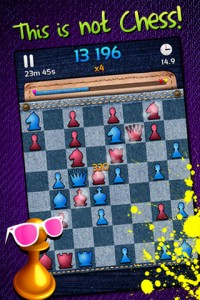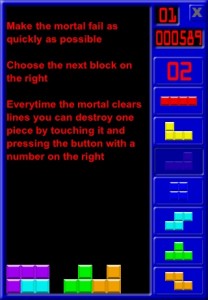The following is in response to an article titled The Current, and Unfortunate, State of Gamification. It was written by my work acquaintance Dakota, who is a relatively new colleague of mine (though I don’t work directly with him). We have interesting conversations about board games, and he was the one who linked me to David Sirlin, (discussed in my last post). If you don’t go read his article, you’ll need to at least know that gamification (in this context) refers to enhancing websites with “game-like features”. I think Dakota’s point is generally that sites aren’t being creative enough in how they add gamification, and generally just add badges and leaderboards, but he touches on a lot of interesting topics while making it.
I’ve been thinking a lot about this article since I read it. Only a few days ago, so I’m late to the conversation, but this blog is stale, so I don’t feel bad posting on an older article.
Anyway, one point I’d make is that, as David [one of the previous commenters] touches on above, the definition of “game” is quite loose. Just as peek-a-boo is a game, full of delight for the extremely young mind (and a game that arguably evolved into the “hidden object” genre that some adults play), so is “collecting” a game that toddlers and adults play. Lots of people refer to collecting badges and getting highscores as the “metagame”. For many, (myself included), it’s not that I find a new game less interesting (far from it) it’s just that a new game is one whose mechanics I might end up taking or leaving, while the metagame is one I already know and love. The metagame is a game that we play in (almost) every game, and (increasingly) in every aspect of our lives! To bring back your ketchup metaphor, [Gamification was compared to food condiments, Dakota argued that its not required for a gourmet meal.] some people just LIKE ketchup, and they put it on everything, breakfast eggs included.
The heart of gamification for me is competition. Messages like “Your friend XXX posted XXX minutes ago” can be a reminder that they are playing against you. To me, even the metagame isn’t nearly as interesting if you can’t compare yourself to your friends and (at the very least) hordes of strangers. (Obviously, this is what leaderboards are about.) The harder it is to see your competition (who else has the badge that I just got?), the quicker you loose the hard-core metagamer.
I do take umbrage with comparing gamification to the Hawthorne Effect. The Hawthorne Effect is increased productivity due to external observation (and I’m no psychology expert, so I have no opinion about whether its effects are debatable). It’s possible that gamification causes people to “feel observed”, but I would argue that gamification is much more like a simple feedback loop, the psychological effects of which are not debated. (The concept was popularly lauded by this wired article in one of the last few issues.) If the Hawthorn Effect is external observation, feedback loops are internal observation (or self observation). One racing game example would be seeing “ghost” images of your previous laps so you can compete against yourself. I think this translates into knowing that you’ll get a badge after one more check-in, or more instantaneously, seeing the counter of how many characters you have left for your status messages on twitter.
This segues nicely into a rant about Random Reinforcement… (I thought I could just link to this, but amazingly, I haven’t immortalized this yet on the interwebs). Essentially, animal trainers know (and research probably shows, although I honestly haven’t looked too much into it) that using positive or negative reinforcement is not nearly as effective as randomly applied positive reinforcement. (Looks like Wikipedia calls this concept “variable rate” (VR) reinforcement. If you follow that link, the graph on the right sums it up pretty nicely.) The rational that I remember is that the animal (or person) is encouraged by the reinforcement they do get, but because they don’t get it every time the effect is that they try harder, thinking the fault somehow lies with their behavior. (The “rant” that I have been known to make is about how this is why people remain steadfast in relationships with partners who treat them badly, but I’ll save that one for later.) Anyway, I followed Kathy Sierra’s horse training link, and I’ll admit that it definitely made me want to read Daniel H. Pink’s Drive. (I’ve added it to my amazon wishlist.) I can very easily imagine that “autonomy, mastery, and purpose” are HUGE motivators, but I don’t see them as in opposition to the concept of gamification at all. In fact, I think there are direct mappings from leaderboards to mastery, and from achievements to purpose.
But let me step back for a minute. It should be obvious by now that I disagree with at least part of the original Hide & Seek article. Specifically the premise that “neither points nor badges in any way constitute a game” seems pretty wrong to me.
I knew it sounded familiar, and after reading through the comments, I realized that I posted a pretty similar sentiment in the comments over there! Here it is for posterity:
Definitely agree with the your semantic argument here. “Pointification” is a better word than “Gamifcation”, and they are definitely different things, but I do not agree with the premise that points != a game.
Remember the meta-game! What about someone who buys and plays through an XBox live game they don’t even want to play, just to get those achievement points? Aren’t they playing a game? I think they are.
What Margaret (at Hide & Seek) is saying seems to be that we should remove all metagame elements from the definition gamification, and just talk about how you can modify the “core mechanics” of your website. (No more ketchup, only entree.) And maybe there is something there in the user experience realm that can approach gameplay. The feeling I get when browsing kickstarter, for example, looking for that next project to back… it’s akin to playing a game, maybe. But I’d argue that a site like Facebook is almost no longer applicable at that point, since so much of the facebook experience is the metagame. Maybe all of social media is the metagame. I know it feels like a game to a lot of people. We just need to remember that, like investment banking, it’s a game with real consequence.




 Here is a screenshot of an intriguing new tetris-variant in the app store,
Here is a screenshot of an intriguing new tetris-variant in the app store,